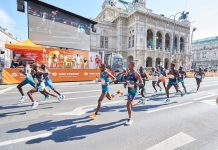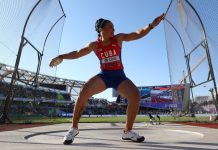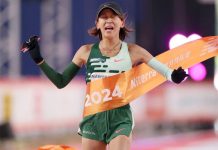Written by Michael Beisty
Reflecting on my first running career one race that stands out is the Sydney Striders Half Marathon of 18 March 1984. The reasons are many, including the professionalism of the event organisation, and a unique combination of club officialdom with enthusiastic volunteers led by race director Philip Caldwell.
From its inception in March 1982, the ferocity of the competition was to become legendary, with many future winners cutting their young half marathon teeth on the hills of Lane Cove River Park. The depth of performance was strong across the board, particularly during the 1980s. There was a challenge in testing yourself against some of the best on a course that could bring you to your knees. Many, including elites, returned year after year, looking for that elusive win or a course personal best. Others ran well as a one-off, or didn’t.
- Half Marathon Origins
The half marathon was the brainchild of Charles Coville, the founder of Sydney Striders Marathon and Road Running Club. Charles, now a life member, was an avid marathon and ultra-distance runner. During a lengthy career he competed in eight Comrades marathons in South Africa, the last in 1997. During the 1970s Charles was active in protests against the Establishment to gain official entry for black runners and women in the Comrades.
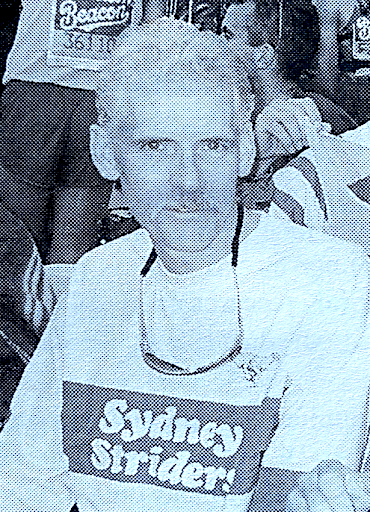
Arriving in Sydney from South Africa in 1978 Charles had some unhappy experiences competing in NSW road racing events. He found race organisation to be poor and not up to the standard of South Africa. In particular he observed inadequate catering to the basic needs of runners during an event, and post-race, and vowed to adopt an over-catering mindset to any event management that he oversaw. Charles had some respectful conversations, even constructive, with the NSW AAAs about improving the standard of race organisation, to no avail. Therefore, he took it upon himself to do something about it, introducing the Sydney Striders to NSW in June 1980, with its distinctive green and white colours, and cheetah logo.
The Blister was the club magazine. Its first issue of July 1980 detailed the clubs aims discussed at their inaugural committee meeting(s) and set out the aspirations of its membership. It is a stark account of a no-nonsense approach to put things right, to get things moving. A central purpose of the club was to ‘promote social contact and group training’. Whilst there was a stated intention to organise a full marathon event in August 1981, it was tentatively decided to start with a half marathon, ideally a flat traffic free course, in late September 1980. These were ambitious targets, ultimately to be overtaken by the hard reality of meeting such timeframes. The club was already talking about sponsorship possibilities. However, in the end, the first Sydney Striders Half Marathon was held on 21 March 1982 and the marathon didn’t eventuate.
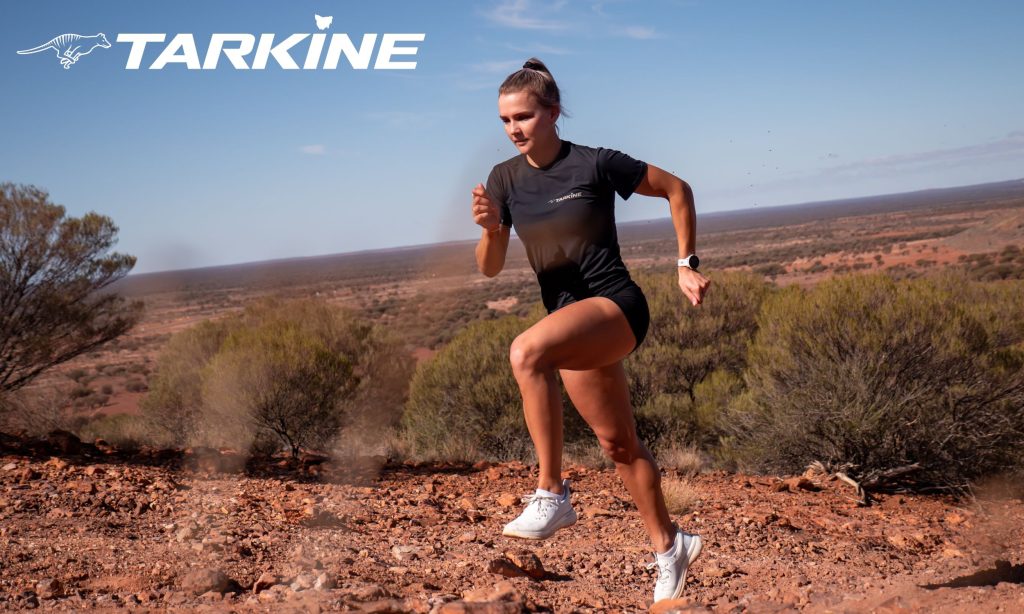
As indicated by its original name, encouraging members to run marathons was a central ethos of the club. Though later, to attract a broader demographic of runners, the use of ‘Marathon’ was dropped from the name and it was rebadged as the Sydney Striders Road Runners Club. The half proved a useful vehicle to promote the club and its various running series and programs of training and races. It was meant to showcase a higher level of event organisation, raise the standard of competition and set an example to other race organisers. It was an unashamed means of recruiting new members.
Sue Hill, a prominent distance runner, was appointed by the club primarily to assist in boosting women’s membership and promote the half to aspiring distance runners. Though women’s participation never exceeded much more than 10% of the field (at its height 14%), and the depth of women’s competition was low compared to the men, the race and the club played a part in lifting competitive standards for women into the future.
Whilst catering for runners of all levels, the race had an elite aspect that was considered essential. The organising committee extended invitations to a range of top runners, paying for domestic flights, accommodation and living expenses. The aim was to attract runners from all parts of NSW, interstate and overseas. As the emphasis was squarely on performance, the club was unapologetic about not paying appearance money. The 1985 half was notable for two overseas winners, 38 year old Wolfgang Krueger of West Germany, a 2:11 marathoner, and 23 year old Raewyn O’Donnell of New Zealand, in her first ever race beyond 10 kilometres. From 1988 cash prizes were awarded to the winners, initially set at $500.
- Event Organisation
Everything ran like clockwork, from the pre-race arrangements, to the operation of the event, post event management and the publication of the results book. Reading the race programme, results book and the accounts of the 1984 race in Striding On, a monthly newsletter published by the Striders, I am struck by the pride of the club in their half. The club’s dedication to the event was evidenced by their decision that members not participate, instead competing in a separately run internal half marathon for members only. This was held the week before the open event.
The Striders half made an immediate impact, winning the 1983 Road Runners Association Award as Australia’s top road race for 16-40k. The event organisation was praised by everyone who ran it. That’s not to say there weren’t hiccups along the way. But the club had an attitude of continuous improvement, acknowledging any mistakes and rectifying them quickly, all in their stride. In many ways it was similar to the Canberra Marathon organisation and there was a level of cross communication between respective organising committees. I understand that Dave Cundy, long associated with the Canberra Marathon, measured and certified the course as accurate.
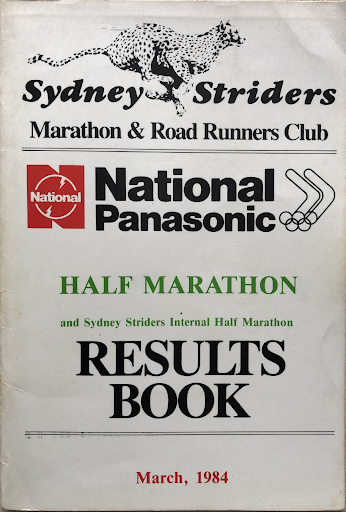
It was a professional approach by an amateur club that garnered massive support from its members, and their families, as volunteers and officials. From advertising executives like Alex Hamill and novelist Bryce Courtenay, and women’s distance running luminaries such as Merri Mack who shared race announcing with Bernie King, the Striders machine drew upon its membership for key industry/community contacts to organise publicity, marketing and design, catering and refreshments, a post-race breakfast, T shirts, prizes, medallions and certificates, results management, course marshalling and other logistics to provide an unforgettable running experience. It was a true team effort to bring such a well drilled event to the NSW distance running fraternity. And they didn’t disappoint.
During its life, there were six race directors, Charles Coville, Philip Caldwell and Bill Flanagan being the mainstays. All were forthright in touting the half as great value for money, a high-cost quality product, to deliver in their words ‘the ultimate half.’ Given the increasing numbers of participants and a progressive increase in entry fees from $2 in 1982 to $15 by 1990, by 1984 there was an attempt to limit entries to 1500. This was also to meet the requirements of the NSW Police and Lane Cover River Park Trust concerning use of the park and roads.
An underlying tension for the directors was the need to attract adequate sponsorship dollars. Shortfalls in sponsorship meant continued pressure to justify what rightly or wrongly was considered a high entry fee. In 1984 $8 was steep given many other races and fun runs had entry fees of $1 or $2. For example, the Harbord Diggers 30k road classic only required a nominal $1 entry, though I understand it was a more grass roots event. As an aside, it is notable that from 1985, when the Striders half hosted the Australian Seniors Championship, men over 60 and women over 50 were given free entry.
- The Course
The course remained essentially the same. There was a change in 1983, when the start was moved from Beaumont Public School West Lindfield to North Ryde High School to improve pre and post-race amenity for spectators and competitors. In 1988 there was a one-off modification because the weir had flooded. In 1991 and 1992 the course was again subject to minor revisions, resulting in additional hills but allowing 80% of the race to remain within national park environs. This was an attempt to counter the impact of the nearby M2 road construction.
I always aimed for sub-70 minutes as a solid half marathon performance, and before race day I was hoping for a time close to 66 minutes. But I hadn’t anticipated the nature of the course. It was described in the Striding On newsletter of January 1984 as an out and back loop course’…a tough but extremely scenic route over undulating, sealed surfaces, traffic free, through Sydney’s beautiful Lane Cove River Park.’ An apt description, maybe, but one that disguised its degree of difficulty to unknowing out of towners and first timers such as myself.
I still have an old Yomix flyer for the 1983 race with my father’s notation of the top 25 finishers scrawled all over it. The course is described as picturesque, no mention of hills! All I heard prior to race day was what a great course it was and that Lloydy had run ‘65’ the previous year (actually 65:58), so it seeped into my brain that ‘it must be fast.’ It wasn’t until the evening before the race, after stuffing myself at Lane Cover Pizza Hut, that I had an opportunity to check out the course and realised how wrong I was.
The 1984 race programme includes a course description advising:
‘the first 4k is largely flat or downhill apart from a climb just 400 metres after the start….then follows the toughest hill on the course, a 1km climb out of the Park to Lane Cove Road….a series of undulations follows taking the runner through the turn point adjacent to the start area and through to the high point of the course at 8.5k…. next comes the fastest part of the course with an almost unbroken 5k descent to Lane Cove River Weir at 13k….then its out and back over the weir for 3k of minor undulations….the last 5k to the finish is predominantly uphill, with a sharp 500 metre climb at 18k….for the final 500 metres the course swings into Wicks Road for a gentle climb before turning into the School for a short (120 metres) sharp rise to the finish.’
Frank McCaffrey always described the course as difficult and tough. In his 1984 race report in Fun Runner he stated that it was the toughest run in the whole NSW calendar and ‘if ever a course was a killer, this one is’. Charles Coville has indicated the intention was to provide a race that would attract runners of all abilities, and bring them back next year, the hilly nature of the course being secondary to the event organisation and the racing experience. As he said to me recently, the course was an ‘is what it is’ proposition, set in beautiful natural surroundings. Whilst I understand this sentiment, I can’t say that I had the wherewithal to admire the scenery. Though I did appreciate the ability to race in a traffic free bush setting.
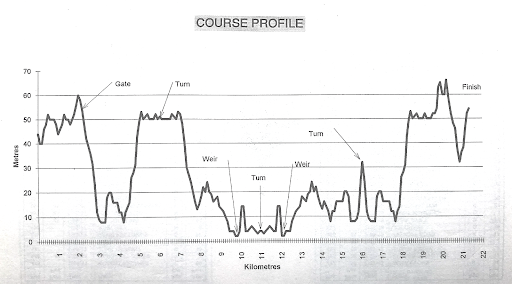
- The Conversion Factor
I have canvassed some past competitors, and Charles Coville, and the general consensus is you can take at least 2 minutes off your Striders half performance – and maybe 3 minutes for women – as a reasonable conversion to what you may achieve on a faster course. A cursory examination of the race performances of some of the elites validates this view. By way of example, Brian Morgan never broke 66 minutes though raced it on many occasions, and his career best half marathon was 64:26. Though past his prime, Steve Austin, Victoria’s powerhouse brickie, ran his career best of 63:54 in Melbourne seven months prior to his 65:52 in the 1985 Striders event. There are similar and much larger disparities for past winners and placegetters but over a wider span of years.
For women, sub-80 minutes was an outstanding performance, achieved on four occasions by Tani Ruckle. Whilst there were only 16 sub-80s run in the history of the race, 85 minutes was a reachable goal for an accomplished club runner, and was achieved 58 times. Of note, a young Kerryn McCann (nee Hindmarsh) won a close race in 1990 dipping under 80:00 by 20 seconds. Tani won the Striders half four times with a best of 75:47 in 1989, her third win, and the course record. Her career best was 73:38 at the Gold Coast in 1988, having run 76 plus in the Striders event in 1986 and 1987. This appears to validate a three minute conversion factor for elite women. Tani’s story is well documented within Australian distance running circles. Suffice to say in 1985, as a total novice to distance running this Canadian born dynamo finished 10th in the Striders half in 86:08 before bursting onto the Australian scene with a 2:49 in the Wang Australian Marathon Championship later that year.
In an article written by Bill Flanagan for Australian Runner in 1987, alluding to Danny Boltz and Tani Ruckle’s 1987 wins, he argued that the course was challenging but can still be fast: ‘If a runner is fit enough to maintain form up the hills there are plenty of opportunities to gain time on the downhills.’ Whilst in awe of Danny Boltz course record of 63:58, to this day I remain unconvinced that the faster downhills compensated for the extensive uphills. A failed repeat attempt in 1985 only served to cement my view. And for slower competitors I suggest the ‘factor’ is more significant.
- The Race of 1984
I came to the 1984 race with a mixed preparation. I had an inconsistent track season, sandwiched between a period of high intensity Spring/Summer track sessions with Dave Forbes and a five weeks block of very solid distance training with Brian Morgan. Of some pride to Novocastrians, on the 11 March 1984, Dave became the first New South Welshman to run a sub-3:40 1500 (5th behind Mike Hillardt’s historic win over Steve Ovett in Sydney). With this body of training behind me, Dave’s performance for inspiration, and a recent close second to Brian in a local 6km fun run I was quietly confident. However, I hadn’t fully appreciated the calibre of the field, and what lay ahead.
5.1 Contenders
1984 was an Olympic year, and this brought more significance to race choices for many of the elite. The Olympic Marathon Trial was to be held on Sunday 8 April in Canberra and the Australian Marathon Championships were scheduled for Sunday 10 June in Sydney. The Striders half attracted a range of competitors who wanted a hit-out before these two marathons.
Of the women, there were 13 entrants with best times of 85 plus or better, but only Sydney local Mora Main (79:26 and the 1983 NSW Cross Country champion) and Queenslander Shane Barrett (79:00), residing in ACT, had sub-80s to their credit (Barrett had won the 1982 Canberra Marathon 2:45:12 and ran 2:45:01 in the London Marathon of 1983). They were dual favourites, though accomplished marathoner Annette Perkins (ACT) was being touted along with Mary Murison (NSW) and Sue Clark (NSW). Perkins and Murison had run solid marathons in 1983, 2:46:59 and a 2:48:19 respectively. Clark, only 22 years of age, had been competing over 25k and 30k distances and was on the improve. Others such as Georgina Moore (NSW), Linda Lenton (ACT) and Margaret Ricardo (NSW) had well established distance racing credentials. The young Ganzevoort sisters (NSW), Jenny (17) and Karen (13), were also in the mix.
The race programme identified 20 male entrants who could run around 68 flat and under. The men’s favourite was Victorian Garry Henry, who was residing in South Australia at that time. Henry’s story is one of Australian distance running folklore. A Traralgon Harrier who ran marathons at a young age and progressed steadily, he competed in the American College system for four years, achieved Australian representation in marathons and the international cross country (three times) and was a 28:18.2 10k track performer. He was an ever-present threat to the top echelon of Australian distance runners, but unable to break through for major Games representation.
Henry was known as a free spirit and a very high mileage man, training up to three times per day. After a stellar year in 1980 when he ran four fast marathons – a close 4th in 2:13:11 in the Australian Olympic trials at Adelaide (behind Barrett, Deek, and Wardlaw), a 2:13:14 win at Vancouver (the Canadian Olympic Trial), and 2:11:37 for 2nd in Montreal, before his celebrated 2:10:09 4th at Fukuoka (ahead of Deek) – he suffered extended periods of injury (bursitis, heel operation, back). However, by all reports, he was now recovered, training well and expecting a good race.
The other main contenders were Victorian Marathon Champion Graeme Kennedy and Brian Morgan, both relatively seasoned marathoners with some international experience. Kennedy had a 2:15:16 win to his name from the 1981 Canberra Marathon. Coincidentally, like Henry, Morgan had won the Vancouver Marathon, the 1981 edition in 2:16:27, ahead of Lawrie Whitty 2:17:52 and the celebrated Roger Robinson 2:18:45, in what was reported as atrocious weather conditions (heavy rain and blustery winds).
Quentin Morley (NSW) age 20, had a 65:24 PB, and a reputation as a prodigious talent. Morley had successfully transitioned to open competition having won the Australian Junior 5000 metres track title and the NSW Open 12k Cross Country Championship of 1983.
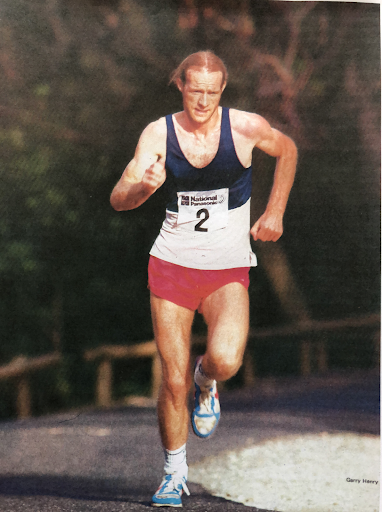
Garry Hand (ACT) a stalwart in his late thirties, was well known as a prolific racer with many high-quality marathons either side of 2:20 to his name. Jim Murphy (ACT) and Daniel O’Dea (SA and brother of Lisa Martin) were lesser-known outside of their states. They went into the race with 67 plus PBs and a range of solid distance races behind them. Robert Spilling (NSW) was also someone to keep an eye on, having finished 4th in the 1983 event after mixing it with the leaders.
Whilst Gerard Barrett was entered, he had experienced periods of prolonged injury and came to the race as an unknown quantity. On the face of it, Henry, Morgan and Kennedy were the major favourites. But this is racing and anything could happen on a course like this, and it did.
5.2 The Race
On a warm and humid morning, the start area was buzzing with runners, spectators and officials. I recall big out of town contingents from Newcastle and Canberra. I am sure Brian Lenton was loitering about somewhere, his wife Linda competing. People were moving around in rushed anticipation. Then before you know it 7:00am arrived, Charles Coville was firing the start gun, and 1500 excited runners were off and racing.
Hand jumped to the front. A largish pack of Morley, Kennedy, Henry, O’Dea, Morgan and Murphy were in tow. Hitting 5k in 15:16 they were 18 seconds slower than Lloyd’s split of 1983. At this stage, I was 10th over 20 seconds behind them, running alongside Spilling.
For the leaders, the remainder of the race can be summarised as: Hand and Kennedy were dropped at 6k and never came back, Morley and O’Dea pushing the pace past the turn point adjacent to the start. The lead pack of five hit the 8.5k high point together and ran hard down the 5k descent to the weir, still 20 seconds down on Lloyd’s pace. After 11k, on the weir section, Henry tested the field and surged up a short rise, gaining 20 seconds on the chasing pack. Thereafter, he continued to stretch his lead. Running strongly over the last 5k Henry took one minute out of Lloyd’s time of 1983 to win in a record 64:42. Behind Henry, Murphy and Morley were at it hammer and tongs through the hills with Murphy holding out Morley in the closing stages 65:52 to 66:12. O’Dea and Morgan were having a similar battle some 30 seconds in arrears before O’Dea beat Morgan out for 4th place in 66:38 to 66:49. The first 14 ran under 70 minutes, the others being Mehil Beckerman 69:26, Mark Hughes 69:28, Robert Spilling 69:31, Harry Ward 69:36, Bill Raimond 69:52, and Daniel Ringuet 69:56, all from NSW.
In the women’s race, Main was out to prove a point, and led from the get go. On her own for the whole race, she established a near-two minute lead over Murison by 10k (35:09) and won in a course record of 77:14. Murison held 2nd place all the way finishing three minutes behind in 80:16. Barrett hunted down Clark and passed her at 14.5k taking 3rd place and keeping it with a solid run home, 80:35 to Clark’s 81:10. Clark improved 12 minutes on her 1983 performance. There was a big gap to Perkins who finished 5th in 82:54. Whilst Main had not achieved her stated aim of sub-77 after slowing too much in the hills (a common theme) she was happy with her race performance which beat her own course record by 2:29.
Mora Main won the inaugural Maria Gemenis-Cruickshank Award that was instituted in memory of Maria, initially as an annual award for the first female finisher. Later, it became known as the Sydney Strider’s Outstanding Achievement Award, given for the best performance of the year by any club member of any age and gender. Maria passed away tragically in the New Year of 1983, aged 38. Twelve months into her running journey Maria joined the Striders in June 1982 and was an active member of the club in administration and as a distance runner. Although a novice to running, Maria loved racing marathons and was a consistent low-3 marathon performer. She set her PB of 3:02:20 in winning the Blacktown/Cities Marathon on 19 September 1982 and ran her last ever marathon one month later winning the Tiger Pulsar Marathon on 3:07:59. Upon her passing, Maria’s family donated her trophy from the Cities Marathon win to the annual award.

Patricia Marshall (NSW), an experienced campaigner, now 40 years of age, ran well to hang tough for 8th outright in a solid race against Perkins, Ricardo 7th 84:59 and Lenton 9th 85:40. Fiona Whelan (NSW) rounded out the top ten with 86:02. Of interest six of these women were aged 30 and above, Main being 35. Whereas for the men only two of the top ten were over 30 (Murphy 32 and Hand 38).
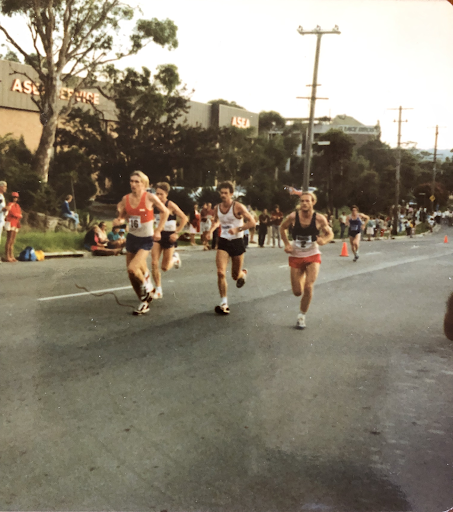
To put the 1984 race results into context the World half marathon bests for men and women were 61:32 by Paul Cummings and 69:14 by Joan Benoit, both of the USA, and both set in 1983. Gerard Barrett, held the Australian best at 62:32 run on 1 November 1981 in Auckland New Zealand. Whilst de Castella had run 61:18 in April 1982 in Milan this was not officially recognised internationally because of a ‘rolling start’ and appeared doubtful in accuracy. The Australian women’s best is difficult to determine though I have been reliably informed it was held by Lisa Martin when she ran 74:04 in the Bohemian Mining Days Half Marathon of Oregon USA, on 16 July 1983.
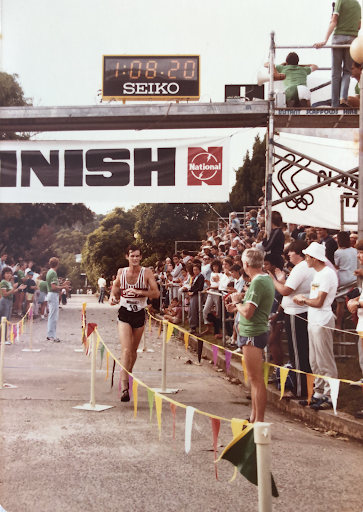
My own race was uneventful. After passing 10k in 31:13, and some jockeying with other fringe competitors, I was 50 seconds behind the smaller lead pack. Having secured 8th place, and still sitting on 66 plus pace, I lost some momentum
through the hills. I hung on to finish strongly in 68:19, running most of the race in not-so-splendid isolation, with Hand (67:20) and Kennedy (67:40) in my sights. Not a PB, but definitely my best competitive performance in a half marathon. The last 120 metres was a cruel push up the steepish incline into the school, legs shot and achilles sore from the pounding. But with spectators packed in close and the ground announcer blaring my name, the atmosphere was near-carnival, akin to a Canberra Marathon experience.
Similar to the experience of many others, this was also a family affair. My father ran above himself, achieving 3rd in the M50 category, aged 50, in a time of 83:57 and my mother, on a short-lived comeback trail, finished 9th in the W45s, 1:41:38. This was to be my father’s best performance from eight outings at the Striders. Mum and Dad also finished 6th in the husband and wife category. In a happy coincidence their combined time of 3:05:35 was mum’s PB for a marathon! Super couple Shane and Gerard Barrett won this category outright in 2:32:31. Gerard having run 71:56 was clearly below his best. Tired but satisfied, the Beistys didn’t hang around for the breakfast, instead high tailing it back home to Newcastle for some well-earned R&R.
For the record, the 1984 winners of the internal race were well known distance runners Keith Canard (age 42) in 73:31 and Sue Hill (41) in 88:30. There were 82 competitors.
5.2.1 Age Category Performances and Prizes/Awards
The club extended a wide range of prizes to the general competitors through random draws and other means. The distribution of prizes and awards reflected the greater depth of participation of men compared to women.
The outright winners, men and women, received a National VCR, second place getters a Seiko Training Timer, and third place some Collector’s Wines. The fourth man received free motel accommodation from Country Comfort. Top 6 women, top 10 men, and age category record breakers received Laser shoes. All age category winners (non-record breakers) received a $50 voucher from Athletes Foot. A range of other prizes were awarded for team category winners of Defence Forces, Workplaces, Running Club:AAA, Running Club:Non AAA and Husband and Wife. 116 medallions were awarded across age and team categories with special medallions awarded for top 3 overseas men and the first overseas woman, oldest man and woman, ‘Last But Not Least’ man and woman, and the first two men from the Defence Forces.
1394 competitors finished below the 2:15 cut off time, 128 women and girls (9 under 18). A sign of the times, the number of mature competitors was thin but relatively high in quality. Age category winners were:
M40-44 Ian Graves 70:32 (rec) – 191 finishers
M45-49 Bill Raimond 69:52 (rec) – 81 finishers
M50-59 Peter Lloyd (father of Andrew) 81:45 – 61 finishers
M60 and over George McGrath 82:51 (rec) – 13 finishers
W40-49 Pat Marshall 85:14 (rec) – 21 finishers
W50 and over Marie O’Donovan 99:23 (rec) – 4 finishers
Bill Raimond, outright winner of the 1982 event, and now 47 years of age, finished 13th in a fantastic time of 69:52 (64:24 age grade equivalent or AGE). Bill had gone into the race with a 68:08 PB and a 2:25:51 Big M Marathon performance from 1982. A highly regarded Masters runner from the South Coast of NSW he was a consistent sub-2:30 marathon runner and invariably ran well in open races. In 1990 Bill would smash the M50 course record with a 74:18 performance.
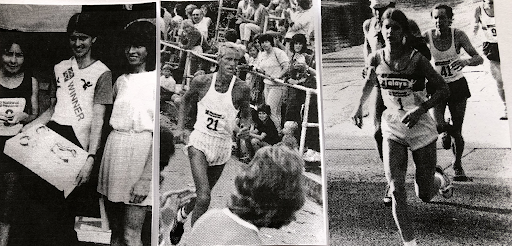
When applying age grade calculations, George McGrath’s performance at 64 years of age, equates to 66:56. However, his M60 record only lasted until 1985 when the great John Gilmour ran 81:31 in the M65-69 category, at the age of 65 – an AGE performance of 65:16. He beat George by 8 minutes.
The oldest man to finish was 69 year old Bill Pease in 98:53 (76:18 AGE). Brenda Every was the oldest woman finisher in 1:52:20 (AGE 96:08). The effervescent Eunice Harris received special mention in the race report as the oldest lady competitor to finish outside the 2:15 cut off (but ran a personal best).
At the other end of the age scale, Paul Arthur, 16 years of age, finished 3rd in the U18 category with a time of 76:07. The winner of this category was also 16, David Woodcock, running a record 74:53. A future City to Surf winner, Paul was to become an accomplished distance runner on the national scene and won the Striders half in 1990, 1993 and 1994.
The young Ganzevoort sisters finished one-two in the under 18s, the younger Karen setting an age category course record of 84:39 in 6th place outright. Jenny ran 89:33, not able to make amends for her 1983 race result when she missed the start by three minutes and was beaten by her sister, who was also 6th in that race.
Typical of this event, an even closer examination of the 1984 results shows a race littered with great Australian ‘open’ distance running champions of the past, present and future. Too many to mention.
5.3 The Immediate Aftermath
A number of the top finishers went on to run well in the Olympic Trial Marathon and Australian Marathon Championships. But Garry Henry wasn’t one of them. Garry finished 16th in 2:27:08 in the trials. The placegetters were Grenville Wood, Robert Wallace and Graham Clews in 2:15:50, 2:16:48 and 2:17:18 respectively. This was a disappointing outcome for Henry who had clawed himself back from injury since 1981 and was viewed as a serious contender.
When interviewed about 20 years later Garry stated: ‘I won the National Half Marathon Championship at Lane Cove in 1:04.42 over a really tough, hilly course but I still wasn’t sure of my fitness for running the Marathon Trial. Unfortunately, probably due to me rushing back to full training and the fact that I ran my guts out in the Half Marathon, I had nothing left three weeks later for the Adelaide Olympic Trial on a tough, windy course. (Ed. Garry needed to run under 2.14 to qualify) I ended up running 2.27 and that was as hard as I could go on the day!’ [authors note: Garry incorrectly described the half as a National Championship and has confused the 1980 Olympic trial location of Adelaide with the 1984 trial event of Canberra]
Mora Main finished a clear 3rd in the Olympic trial running 2:41:25 behind Lisa Martin 2:35:05 and Megan Sloane 2:40:25. Whilst this proved to be her career best time, unfortunately, she missed the Olympic qualifying time of 2:40. Mora also ran the Australian Championship in 2:46:00 behind the winner Kiwi Ngaire Drake 2:41:26. Mora was 5th outright and first Australian.
- The Demise
After a promising start in 1982, the ‘eighties’ were the half’s halcyon years with a significant depth of performance and high participation rates. The event had major sponsors of Yomix (1983), National Panasonic (1984,1985 and 1987), Royal Life Insurance (1986) and Canterbury Mazda (1989 and 1990). There was no major sponsor for 1982 and 1988. At one stage a national half marathon road series, to be sponsored by Royal Life Insurance and include the Striders half, was proposed. Whilst there was some initial impetus for this series during 1986, these plans did not come to fruition. Thereafter, a downturn in the national economy resulted in the lack of a major sponsor in 1991 and 1992, before South African Airways came on board in 1993 and 1994.
The club put great effort into the organisation of the half marathon and its continued improvement, that often included the surveying of participants to elicit feedback. However, with the passage of time numbers dwindled, event organisation was becoming problematic, and by 1990 the club committee was turning its attention towards its 10k series, questioning the continuance of the half marathon. Some were aggrieved that club members were excluded from competing in the open event, and felt the ratio of volunteers/officials to participants had become farcical. As a compromise it was agreed that the top three Striders men and women be allowed to compete in the open event.
The event was always held in March. However, with the Strider’s commitment to the open event starting to wane, much discussion ensued about its future viability. Consequently, the Striders were not in a position to hold the 1990 half in March, and deferred the race to September. It didn’t return to a March date until 1993. Apart from the 1991 race when it was the designated NSW Half Marathon Championship the date change saw a significant reduction in the number of entrants. The original March date was viewed by the broader distance running community as ideal timing to test racing fitness in preparation for Winter marathons, an opportunity lost by scheduling in September. And the absence of a March event meant that a swathe of past and potential entrants had likely gone elsewhere. The damage was done.
All of these factors, combined with changes to the course and the advent of the faster Sydney Morning Herald Half Marathon in May 1992, diminished the appeal of the Striders half. In 1994, with a total number of finishers less than 300 it was a long way from its heady days of the mid 1980s. And so it came to be that the Striders open half marathon ended in 1994. The Striders focused on its 10km series and the half marathon became an internal club event that continues to this day.
- Concluding Comments
The Sydney Striders Half Marathon ushered in a new era of professional event management in NSW where the racing experience was put front and centre for runners of all abilities. It was a leader in the rise of an Australian network of distance events that shook the established fun running and AAA road running scenes from their comfortable existences, the former largely hit and miss and the latter suffering from long standing inertia. That the open ‘invitational’ event ceased reflects the difficulty of competing for scarce sponsorship resources at a time when Australia was transitioning to prize money races and operational costs to deliver a quality event were becoming exorbitant.
But they were good days, attracting competitors and running families from far flung parts of NSW, interstate and overseas because of its reputation for organisational excellence and tough competition. Thumbing through past results I can see a high level of returnees to the half, some who were elite who never won but always came back (Morley and Spilling come to mind) and others who were family oriented who always came back. That was the beauty of this race. Similar to the Canberra Marathon I’d have to say it wasn’t a particularly fast course, but you could run a fastish time, if you were ‘on’. And the professionalism was appreciated.
I understand the Striders club, with a membership greater than 700, are celebrating their 40th anniversary on 29 October 2022, two years late because of the pandemic. A special occasion, no doubt, and another opportunity to decide the club’s Outstanding Achievement Award, dedicated to the memory of Maria Gemenis-Cruickshank.
Some have quipped that their anniversary is actually a celebration of 42.2 years of the club’s existence, a play on words that reflects the delay in holding the event. I wish them well for at least another 40 years, knowing that we will not see the like again of an event that combined the grit and camaraderie of a tough race hard fought, with the organisation and care of a well-oiled machine that was typical of the Sydney Striders Half Marathon. In conclusion, I end with an honour roll, extracted from the 1994 results book.
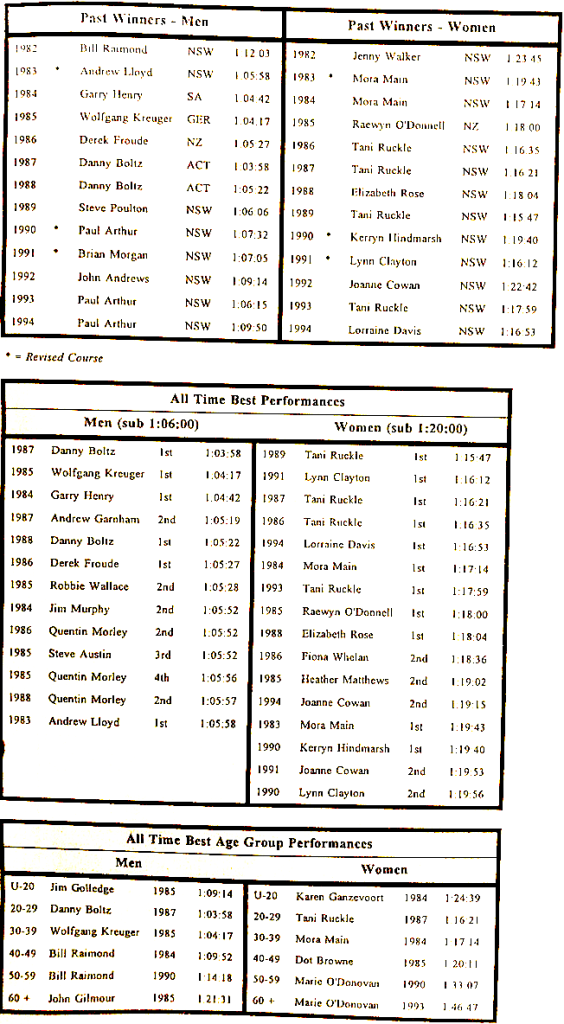 Primary References and Sources
Primary References and Sources
Athletics Australia, Australian All time List as at 14 July 2022, compiled by Jenes, P (AA statistician), McEwan, F and Tarbotton, D
Ausrunning.net.au
De Castella, R & Jenkins, M, Deek – the making of Australia’s World Marathon Champion, 1984
[Documentation from/Conversations with/Recollections of] Charles Coville during September 2022
Family diaries of the Beisty family
Garry Henry. Australia’s Enigmatic Marathon Man, approx. 2002: available from
http://www.grcc.net.au/documents/Interviews/Garry_Henry.pdf
Men’s non-legal half-marathon/All-time men’s best half-marathon, available from http://www.alltime-athletics.com/mhmarano.htm–http://www.alltime-athletics.com/mhmarano.htm
Results books for the Striders Half Marathon – 1984, 1985, 1989, 1992, 1993
Striding On, Vol 1, Iss 9, January 1984
Striding On, Vol 2 Iss 3, April 1984
The Blister, Vol 1 No 1, July 1980
Wikipedia, Half marathon world record progression, available from https://en.wikipedia.org/wiki/Half_marathon_world_record_progression
Magazines:
Flanagan, B, Article titled Striders Set the Standard, Australian Runner, 1987, supplied by Charles Coville
Lenton, B & McCaffrey, F, Race report titled Royal Life Half Marathon, Fun Runner Vol 8 No 2 June-July 1986
Lenton, B & McCaffery, F, Race report titled National Half Marathon, Fun Runner Vol 6 No 2, June-July 1984
McCaffrey, F, Race report titled Sydney Striders Half Marathon, Fun Runner Vol 4 No 3, August-September 1982
NSW Road Running Association, Article titled Road Running, Fun Runner Vol 8 No 1, April-May 1986
Stephens, P, Article titled Running Down Memory Lane, Australian Runner Vol 2 No 9, April-May 1984





